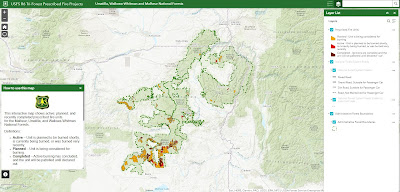Fire management officials on the Umatilla National Forests are preparing to implement fall prescribed burning activities to reduce the risk of severe wildfire in the future.
While
we have seen our fair share of smoke and fire over the last few months, conducting
prescribed fire is critical to reduce the intensity of wildfire and to help
protect our communities for the future. Reduction
work done in the upper reaches of Wenatchee Creek and Indian Tom Drainages is a
prime example of this as our previous fuels reduction work drastically reduced the
rate of spread and impacts of Cougar
Creek Fire this year.
The
planning of a prescribed fire involves meticulous care and consideration,
especially after an active wildfire season. Umatilla National Forest burns only
when objectives can be met, which include creating fire-resilient landscapes
and protecting values at risk, like homes, infrastructure, and drinking water.
Fire
managers also account for smoke and recent wildfire impacts to the local
community prior to burning. Prescribed fire is an important component of
natural resource management, in addition to commercial and non-commercial
thinning, which also help reduce hazardous fuels around our communities.
Umatilla
National Forest works closely with the Oregon Department of Forestry and
Washington Department of Natural Resources in accordance with the State’s Smoke
Management Plans to determine when, where, and how much is burned on a daily
basis. Potential smoke impacts, looking at volume of smoke, direction of
spread, and mixing heights, are determined prior to each burn. All burns
will be monitored until no heat is found within the unit and fire managers
declare the burn out.
Frequent,
low-intensity fire is essential for healthy forests and reducing the risk of
high intensity wildfire and an effective tool for removing excessive amounts of
brush, shrubs, and trees, while also encouraging the growth of native
vegetation. In addition to reducing wildfire risk, prescribed fire also
improves overall forest health and resilience to insects and diseases, and
enhances habitat for elk, deer, and other wildlife. Forest Service prescribed
fire programs allows fire to play its natural role on the landscape under
controlled conditions.
Prescribed
fires often follow other treatments such as timber sales, thinning, and other
forms of fuels management and each prescribed burn represents many years of
planning and preparation to ensure burn operations meet prescriptive conditions
that allow for successful burns that provide multiple benefits to resources.
Prescribed
fire information for the Malheur, Umatilla, and Wallowa-Whitman National
Forests is available to the public on a tri-forest online map. The map is labeled and
color-coded to show each burn unit’s status: planned, active,
or completed. Additionally, forest users can view other
features including current and past-year burn units, National Forest boundaries
and State wildlife management boundaries.
To
learn more about current and planned prescribed fires in the area, please
visit:
·
Online prescribed fire map for
the Malheur, Umatilla, and Wallowa-Whitman National Forests (example image below)
·
Blue Mountain Prescribed Fire
Council Blog
·
Blue Mountain Interagency
Dispatch Center
·
John
Day Interagency Dispatch Center and Burns Interagency Communication Center
Additional information about the Umatilla National Forest is available at https://www.fs.usda.gov/umatilla.
###

No comments:
Post a Comment
Note: Only a member of this blog may post a comment.